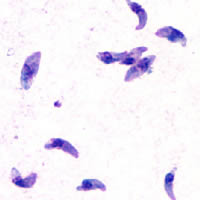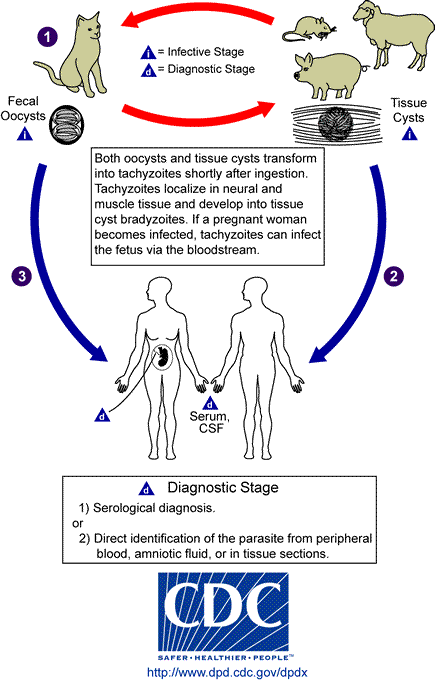Written in 2004

Many of you may have heard of Toxoplasmosis and it’s relationship to pregnant women. I know as a small animal practitioner, I get many calls from pregnant women who are wondering if they need to get rid of their cat. Here is the scoop… Toxoplasma is protozoan parasite that is carried by rodents and birds. Cats are infected when they eat the mouse or bird and then the Toxo organism will live part of its life cycle in the cat. The organism is passed in the cat feces and then must sit in the environment for a couple of days before it becomes infective to people or to our goats. (In other words, you could eat fresh cat poop and NOT get sick, the stool must be OLD to be infectious! This is a key point.) Once cats become infected with Toxo they will always have it, but they will only pass it in the stool for a brief time just after they are first infected. Most cats only pass the organism in the stool ONCE in their lives and usually when they are kittens. The exception to this would be if an older cat got another disease that suppressed their immune system (such as feline leukemia or feline aids).
When kittens that are shedding the organism defecate in the hay, feed bins, or bedding, the goats can potentially become infected. People get infected when cats bury their stool in the garden and people work in the garden without gloves or face masks…yes you can actually get this by breathing the dust that is carrying the parasites. Goats can also get it this way. Another way you can get the organisms is by eating meat that contains the parasites. When goats, cows, pigs or other animals are infected by the parasite, they (the organisms) don’t really know what to do so they swim around in the animal’s body and form little “cysts” in the muscle tissues. When you eat the cysts in the muscle, you can get Toxo. What most folks are concerned with is cleaning the litter box, but if this is done daily the poop will be fresh and the organisms will not be infective yet.

So what is the big deal? Well….Toxo is one little bug that can cause big, big problems. People that are not pregnant and that have good immune systems generally just get slight flu like symptoms and don’t even know it was the bug. It doesn’t really go away, it goes to your brain tissue and some in your muscle tissue and just sits there for years. If you get AIDS or Cancer and are immunosuppressed for some reason, the little critters can come out of their “cysts” and cause severe problems or even death. The biggest problem is in pregnant women or young children with immature immune systems. The organism will infect unborn babies and cause severe birth defects or miscarriages. It can get into the retina of the eyes and cause blindness or it can get into the brain and cause neurologic disease in children.
So why are we concerned with it in goats? It does many of the same things as it does to people! If the doe gets infected while she is pregnant, the organism can multiply in the placenta and infect the fetus. This can cause miscarriages and stillbirths, weak kids and kids with neurologic disease. Occasionally, but not often, the infected doe will run a fever, but most show no clinical signs other than abortion. If the doe has a bad immune system she may develop a neurological form of the disease. Is there another reason we worry about this in goats? Yes—infectious organisms can be passed in the milk and will also be in the muscle of the goat. As I said earlier, adults that have a good immune system could get infected by drinking the milk but they will show no or only very mild signs of a problem. However, infants or immune compromised people that drink infected goat milk could come down with very severe disease. Pasteurization or boiling of the milk will kill the organism. Goat meat that is infected could also infect a human and that is one reason to cook your meat until the juices run clear. Meat does not have to be well done but the juices must not be pink or red, they must be clear.
How can we diagnosis this? Because most adult does do not show symptoms it is hard to diagnose it in the adult animal. Diagnosis is most reliable if the aborted fetus and the placenta are sent to the lab. If your doe aborts, do NOT let her eat the placenta and do NOT throw it away. The placenta is the key to diagnosing many causes of abortion (not just toxoplasma.) Wrap everything up, including the aborted fetus, and put it in a plastic bag in a refrigerator. Most of the time it can actually be frozen but not always. Until your vet examines the tissues and determines which tests need to be run, it is best to refrigerate. Remember, you cannot refrigerate it forever without the tissue breaking down. Examination and laboratory analysis need to be done within 2-3 days maximum. Blood tests can be run on a weak kid but the blood must be drawn BEFORE the kid gets colostrum. Antibodies may be passed from the doe to the kid in the colostrum that would make the test positive. These antibodies would be present in the doe if she had ever in her life been infected. If she was infected BEFORE the pregnancy the Toxo will not cause a problem. The problem is only if she is infected during the pregnancy. Therefore, antibodies passed to the kid will show in blood tests but do NOT mean that Toxo was the problem.
How do we prevent this? That is a tough problem. Many folks recommend getting rid of your barn cats. The problem is that stray cats passing through your barn or pasture can also shed the organism. Other people have advocated having a few, neutered barn cats. These cats are not going to be having kittens (the age most likely to shed the parasite) and they are going to hopefully chase off any stray cats that come around. The most successful method of preventing this is to keep the feed and the hay in areas where cats cannot get to it. Cover your hay feeders and keep the hay off the ground. Keep feed in closed containers. Clean any hay or feed that could potentially have cat feces in it daily. (Remember-fresh feces is not a problem, the organism cannot infect you or your goats unless it has sat in the environment for a couple of days.) Even this method is difficult and we all need to be on the lookout for signs of a problem.








Leave A Comment